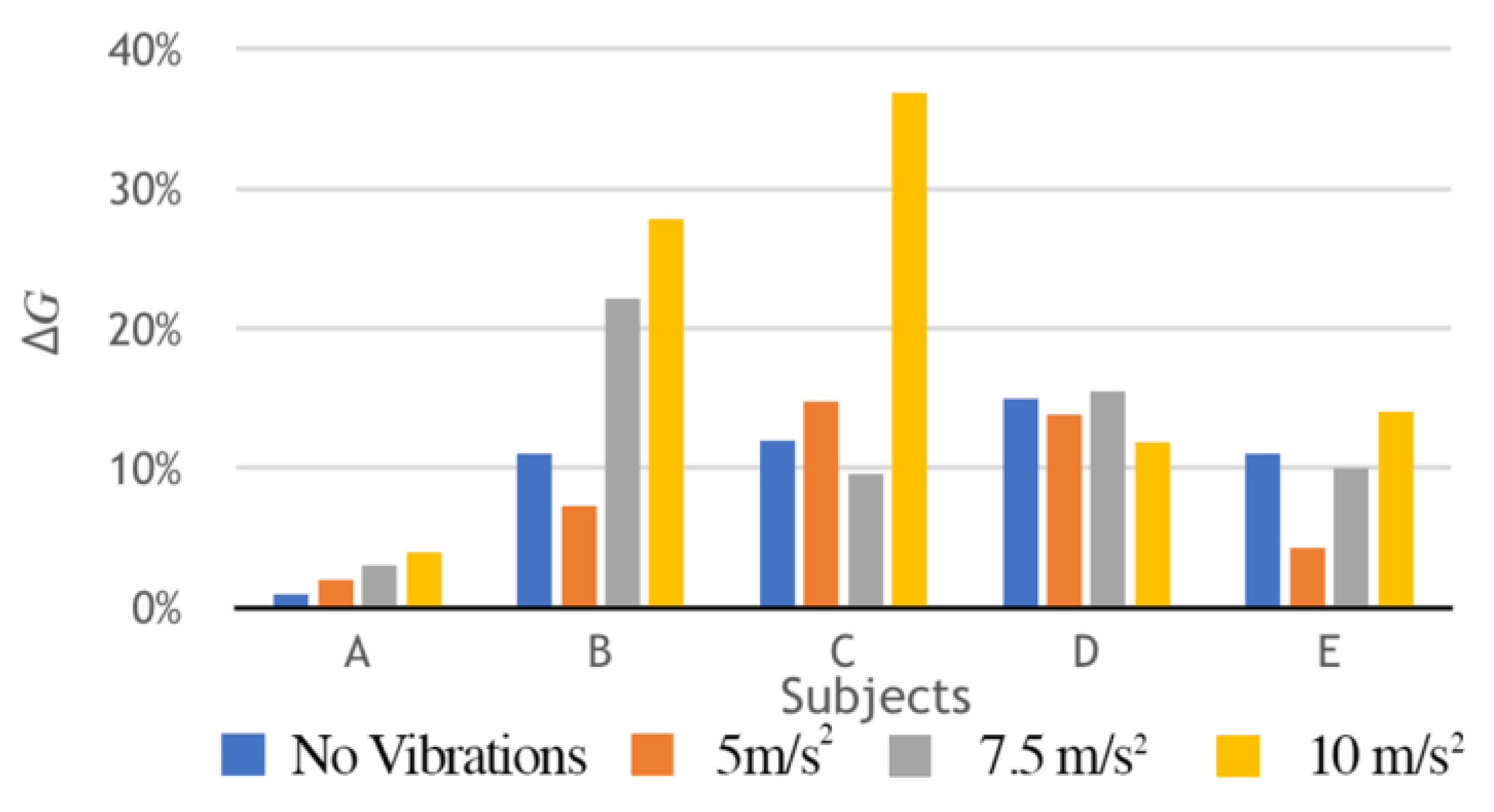Interference of Vibration Exposure in the Force Production of the Hand–Arm System †
Abstract
1. Introduction
2. Material and Methods
2.1. Subjects
2.2. Motor Task
3. Results
4. Discussion
5. Conclusions
Author Contributions
Funding
Institutional Review Board Statement
Informed Consent Statement
Data Availability Statement
Conflicts of Interest
References
- Martin, B.J.; Parc, H.S. Analysis of the tonic vibration reflex: Influence of vibration variables on motor unit synchronization and fatigue. Eur. J. Appl. Physiol. 1997, 75, 504–511. [Google Scholar] [CrossRef] [PubMed]
- Fattorini, L.; Tirabasso, A.; Lunghi, A.; Di Giovanni, R.; Sacco, F.; Marchetti, E. Muscular forearm activation in hand-grip tasks with superimposition of mechanical vibrations. J. Electromyogr. Kinesiol. 2016, 26, 143–148. [Google Scholar] [CrossRef] [PubMed]
- Fattorini, L.; Tirabasso, A.; Lunghi, A.; Di Giovanni, R.; Sacco, F.; Marchetti, E. Muscular synchronization and hand-arm fatigue. Int. J. Ind. Ergon 2017, 62, 13–16. [Google Scholar] [CrossRef]
- Cavacece, M. Incidence of Predisposing Factors on the Human Hand-arm Response with Flexed and Extended Elbow Positions of Workers Subject to Different Sources of Vibrations. Univers. J. Public Health 2021, 9, 507–519. [Google Scholar] [CrossRef]
- ISO 5349-1:2004; Mechanical Vibration Measurement and Evaluation of Human Exposure to Hand-Transmitted Vibration, Part 1: General Requirements. International Organization for Standardization: Geneva, Switzerland, 2004.


| Subject | |||||
|---|---|---|---|---|---|
| Subject | A | B | C | D | E |
| Height [cm] | 170 | 167 | 170 | 184 | 181 |
| Weight [kg] | 103 | 72 | 65 | 93 | 88 |
| Gender | M | M | M | M | M |
| MVC 1 [N] | 470 | 400 | 380 | 470 | 330 |
| MVC 2 [N] | 490 | 430 | 360 | 460 | 310 |
| MVC 3 [N] | 490 | 400 | 350 | 450 | 330 |
| MVC 30% [N] | 140 | 120 | 110 | 140 | 100 |
| Subject | No | Vibrations | ||
|---|---|---|---|---|
| Vibrations | 5.0 [m/s2] | 7.5 [m/s2] | 10.0 [m/s2] | |
| Time [s] | ||||
| A | 205 | 146 | 140 | 145 |
| B | 264 | 312 | 242 | 213 |
| C | 288 | 204 | 202 | 280 |
| D | 275 | 307 | 286 | 307 |
| E | 303 | 305 | 302 | 295 |
Disclaimer/Publisher’s Note: The statements, opinions and data contained in all publications are solely those of the individual author(s) and contributor(s) and not of MDPI and/or the editor(s). MDPI and/or the editor(s) disclaim responsibility for any injury to people or property resulting from any ideas, methods, instructions or products referred to in the content. |
© 2023 by the authors. Licensee MDPI, Basel, Switzerland. This article is an open access article distributed under the terms and conditions of the Creative Commons Attribution (CC BY) license (https://creativecommons.org/licenses/by/4.0/).
Share and Cite
Cavacece, M.; Tirabasso, A.; Di Giovanni, R.; Monti, S.; Marchetti, E.; Fattorini, L. Interference of Vibration Exposure in the Force Production of the Hand–Arm System. Proceedings 2023, 86, 36. https://doi.org/10.3390/proceedings2023086036
Cavacece M, Tirabasso A, Di Giovanni R, Monti S, Marchetti E, Fattorini L. Interference of Vibration Exposure in the Force Production of the Hand–Arm System. Proceedings. 2023; 86(1):36. https://doi.org/10.3390/proceedings2023086036
Chicago/Turabian StyleCavacece, Massimo, Angelo Tirabasso, Raoul Di Giovanni, Stefano Monti, Enrico Marchetti, and Luigi Fattorini. 2023. "Interference of Vibration Exposure in the Force Production of the Hand–Arm System" Proceedings 86, no. 1: 36. https://doi.org/10.3390/proceedings2023086036
APA StyleCavacece, M., Tirabasso, A., Di Giovanni, R., Monti, S., Marchetti, E., & Fattorini, L. (2023). Interference of Vibration Exposure in the Force Production of the Hand–Arm System. Proceedings, 86(1), 36. https://doi.org/10.3390/proceedings2023086036






